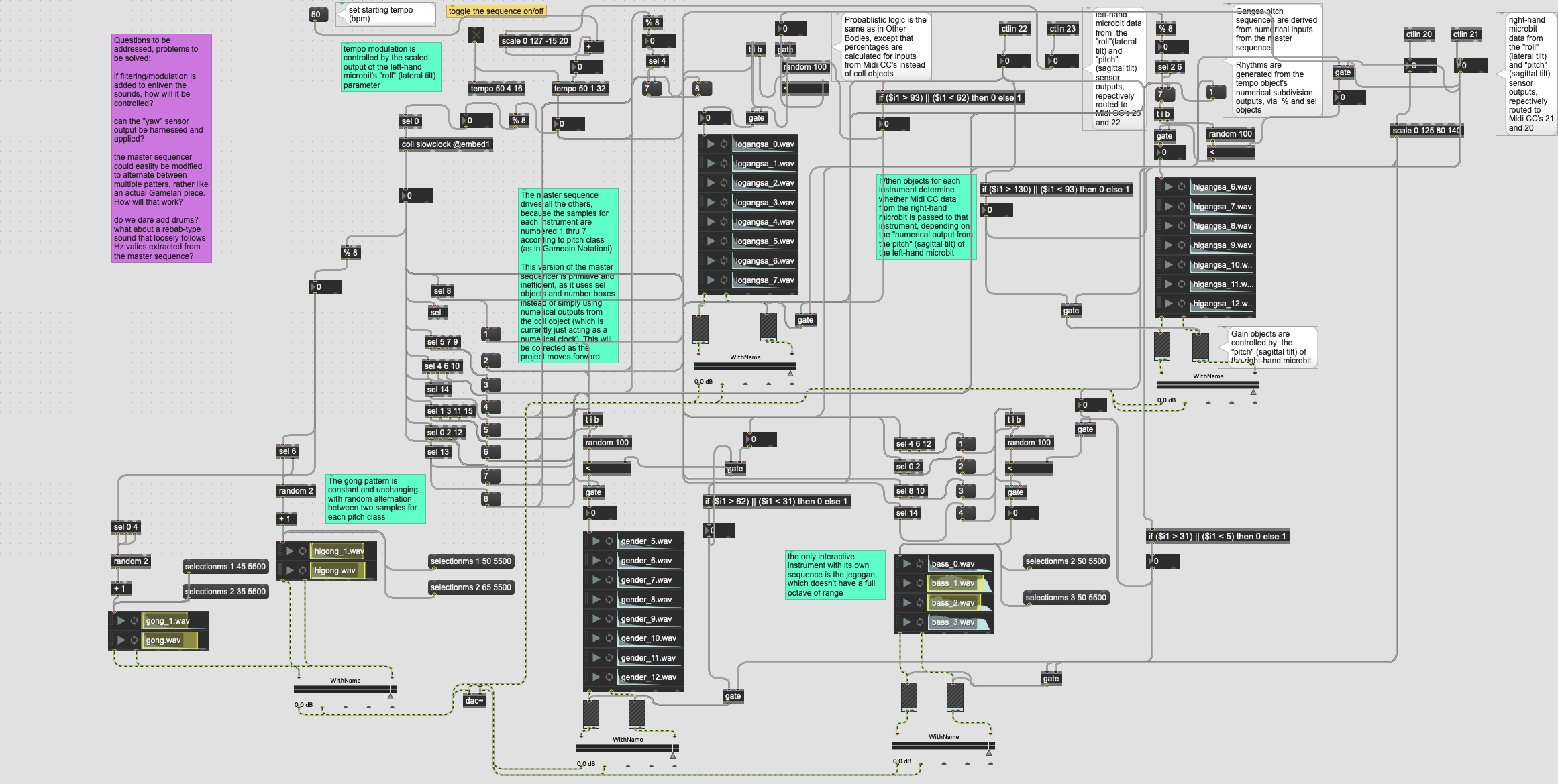
Probabilistic Gamelan
A Work In Progress
Click here or scroll down for full video
Click the image above to Enlarge
The Probabilistic Gamelan is a direct descendant of the Hateword Tweets (precision instrument 1) section of the Other Bodies Max/MSP patch. Its fundamental architecture is the same: Four different playlist objects are connected to sequencers whose trigger signals are gated by the percentage logic “module” from Other Bodies. Those modules (one for each of the four interactive instruments) compare dynamic numerical inputs against a set value of 100 to determine the probability of a trigger cue being passed from the sequencer to the playlist object. However, the Probabilistic Gamelan compares input signals from Midi CC 21 instead of Coll objects to determine % probability.
Here’s where things get interesting: The Midi CC used to determine probability is controlled by gestural data from a micro:bit which is held in the player’s right hand. The micro:bit ‘s wireless sensor outputs are routed through Glover, which can read and scale three gestural parameters: “pitch” (sagittal tilt) “roll” (lateral tilt) and “yaw” (horizontal tilt relative to a user-determined center.) The “roll” parameter from the right-hand micro-bit controls Midi CC 21, and is scaled so that a palm-downward position means there is a 0% chance of triggers being passed form the sequencer, while a thumb-upward position means there is a 100% chance of triggers being passed from the sequencer. The probabilistic fun all takes place within those 90 degrees of wrist rotation.
Meanwhile, the “pitch” parameter is mapped to Midi CC 20, and routed to gain~ objects that control each playlist’s output level. As a result, when the right forearm is pointed downward at an angle about 70 degrees from horizontal, the instrument is functionally muted. When the right forearm is pointed upward (also at an angle of about 70 degrees) the instrument is extremely loud–as long as its % probability is a nonzero number, of course.
So much for the right-hand micro:bit. The left-hand micro:bit also uses the “roll” and “pitch parameters, but they serve different functions: “roll is routed to Midi CC 23, which modulates the bpm of the tempo object that drives all the sequences. It’s scaled so that a thumb-upward position means the sequences run at 35 bpm, while a palm-downward position means the sequences run at 70 bpm.
The left-hand microbe’s “pitch” parameter (Midi CC 22) is routed to four if/then objects–one for each interactive instrument. Each of these objects outputs a 0 unless the signal from Midi CC 22 falls within a specific range: 93 to 127 for the high Gangsa, 62 to 93 for the low Gangsa, 31 to 62 for the Reyong and 5 to 31 for the Jegogan. Whe CC 22’s output falls within an if/then object’s range, it outputs a 1, opening a gate that allows the outputs form the right-hand micro:bit to reach the probability and level inputs of the associated instrument. This means that when the left forearm points upward at a steep angle (I didn’t measure degrees; scaling can be adjusted in Glover) the right hand controls the levels nd probability of the high Gangsa. When the left forearm points upward at a gentle angle, the right hand controls the low Gangsa. A gentle downward angle and it’s the Reyong. Steep downward angle? Jegogan. If the left forearm points down at the floor, the right hand doesn’t control anything, and the player can use it for non-gamelan purposes. The Gong isn’t interactive in this iteration of the patch.
Please excuse me if any of the terminology I use in this description is unorthodox or just plain wrong. As you can see, I have a lot to learn when it comes to Max and music technology in general. I wanted to share this project partly because it’s fun and much lighter in tone than the other materials in my portfolio, but also because, if this project were a tender little rambutan sapling, the MMC program would be a fantastic, beautiful tropical island were it could grow, thrive, connect to a mycorrhizal network that speaks its language and eventually, bear fruits that are sweeter, spikier and more colorful than if would anywhere else.
Full version of the excerpt above